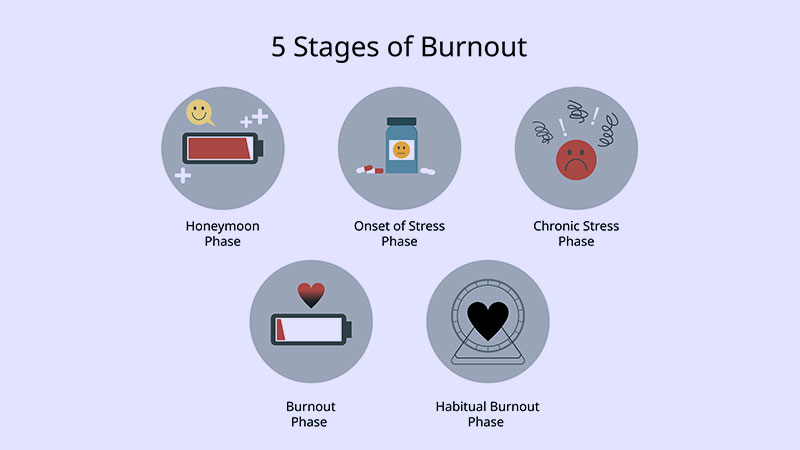In today’s fast-paced world, burnout has become a prevalent issue affecting many individuals across various industries.
Understanding the stages of burnout can help individuals recognize the warning signs and take proactive steps to prioritize their well-being.
From the initial feelings of excessive stress and fatigue to the eventual state of physical, emotional, and mental exhaustion, the journey through burnout is a gradual process that can significantly impact one’s quality of life.
By familiarizing oneself with the five stages of burnout, individuals can better navigate their way through this challenging experience and seek the necessary support and resources to recover.
Exploring each stage in-depth can provide valuable insights into the progression of burnout and empower individuals to make informed decisions to prevent its long-term effects on their health and overall happiness.

What is Burnout?
Burnout is a state of emotional, physical, and mental exhaustion resulting from prolonged exposure to high stress levels, causing feelings of overwhelm, detachment, and reduced performance.
Recognizing symptoms like chronic fatigue, irritability, and decreased concentration is crucial to address burnout early and avoid serious health consequences.
Seeking support, setting boundaries, practicing self-care, and prioritizing mental well-being are important steps in preventing and recovering from burnout, which may require lifestyle changes and relaxation techniques to maintain a healthy work-life balance.
The 5 Stages of Burnout
Burnout is a state of chronic stress that can lead to emotional, physical, and mental exhaustion. It typically progresses through several stages. Here are the five stages of burnout:
Stage 1: Honeymoon Phase

In the initial phase of burnout, individuals may experience heightened enthusiasm and energy for their work.
They might throw themselves into tasks, working long hours without feeling fatigued. However, this excessive engagement can set the stage for later burnout.
As burnout progresses, individuals in the next stage may start to feel a growing sense of cynicism and detachment towards their work.
This can lead to decreased productivity and a negative attitude towards tasks that were once enjoyable.
Stage 2: Onset of Stress

As burnout progresses, the onset of stress becomes more apparent. Individuals start to feel the pressure of their workload, leading to irritability, lack of focus, and mild anxiety.
At this stage, it’s important to recognize these signs and take steps to manage stress effectively. This is essential to prevent burnout from escalating further and impacting both mental and physical well-being.
Implementing stress-reducing techniques such as mindfulness, exercise, and setting boundaries can help individuals cope better during this critical stage of burnout.
Stage 3: Chronic Stress

In the chronic stress stage, individuals experience a persistent feeling of being overwhelmed. Physical symptoms like headaches, digestive issues, and sleep disturbances may become more frequent.
Coping mechanisms like social withdrawal or reliance on unhealthy habits might emerge. This stage can significantly impact one’s daily life and overall well-being.
It is crucial to recognize these signs and symptoms to address burnout effectively before reaching the point of complete exhaustion and depletion in the final stage.
Stage 4: Burnout

At the peak of burnout, individuals face a state of emotional, physical, and mental exhaustion. They may become cynical, detached, and disengaged from their work, leading to feelings of ineffectiveness and a sense of reduced accomplishment.
Seeking professional help and support is crucial at this critical stage. It is important for individuals to recognize the signs of burnout and take action before reaching this peak stage.
Prioritizing self-care, setting boundaries, and practicing stress-management techniques can help prevent burnout from escalating to such a critical level.
Stage 5: Habitual Burnout

In the final stage, habitual burnout, the condition becomes ingrained in one’s lifestyle. It’s characterized by a constant state of exhaustion, persistent negative emotions, and a feeling of being trapped in a cycle of burnout.
Recognizing the signs early and implementing preventive strategies is essential to avoid reaching this stage.
Some common signs of habitual burnout include ongoing fatigue, increased irritability, and a sense of hopelessness that can greatly impact one’s quality of life.
Taking proactive measures to address stressors and prioritize self-care is crucial to prevent reaching this severe stage of burnout.
What Are The Symptoms of Burnout?
Burnout is a state of emotional, physical, and mental exhaustion caused by prolonged and excessive stress.
It often results from work-related stress but can also arise from other areas of life. Recognizing the symptoms of burnout early can help in managing and mitigating its effects.
Here are common symptoms of burnout:
Emotional Symptoms
Chronic fatigue manifests as persistent feelings of exhaustion and a lack of energy, even after a good night’s sleep. Irritability increases, leading to frequent outbursts or frustration over minor issues.
Detachment is felt through disconnection or indifference towards work, tasks, or people, including feeling less empathetic towards colleagues.
Reduced motivation becomes noticeable through a decline in enthusiasm for work or activities that previously brought joy.
Physical Symptoms
Sleep disturbances become common, with trouble falling asleep, staying asleep, or experiencing non-restorative sleep.
Frequent tension headaches or migraines occur more often. Muscle tension is persistent, particularly in the neck, shoulders, or back. Gastrointestinal issues such as stomachaches, nausea, or changes in appetite become prevalent.
Behavioral Symptoms
Decreased performance at work or in daily tasks becomes evident. Avoidance of responsibilities and tasks, including missing deadlines or neglecting duties, increases.
Social withdrawal from interactions, including avoiding friends, family, and colleagues, becomes more frequent.
Increased absenteeism from work or social engagements due to feeling overwhelmed or unwell is observed.
Cognitive Symptoms
Difficulty concentrating, trouble focusing, or making decisions leads to a decrease in cognitive performance.
Memory problems, particularly short-term memory issues or difficulty recalling important information, become more noticeable.
A negative outlook on work, colleagues, or oneself emerges, with pessimistic or cynical thoughts prevailing.
Long-term Effects
Mental health issues such as anxiety, depression, or other mental health conditions become more likely. The risk of chronic illnesses increases due to ongoing stress and a weakened immune system.
Strain on personal and professional relationships occurs due to decreased emotional availability and increased irritability.
Recovery Strategies for Burnout

Recovering from burnout requires a combination of immediate relief strategies and long-term changes to ensure sustained well-being. Here are some effective recovery strategies:
Seek Professional Help
When experiencing burnout, one of the most crucial steps towards recovery is seeking help from mental health professionals, therapists, or counselors.
They can provide valuable support, guidance, and techniques to help individuals cope with burnout symptoms effectively.
Practice Mindfulness and Relaxation Techniques
Engaging in mindfulness practices such as meditation, deep breathing exercises, or yoga can significantly reduce stress levels and promote emotional well-being.
These techniques help individuals regain a sense of calm and focus, combating the effects of burnout.
Establish Healthy Boundaries
Setting clear boundaries in both personal and professional life is essential for recovery from burnout. Learning to say no, delegating tasks, and prioritizing self-care can prevent future burnout episodes and foster a healthier work-life balance.
Engage in Physical Activity
Regular exercise is not only beneficial for physical health but also plays a vital role in combating burnout.
Physical activity releases endorphins, the feel-good hormones, reducing stress and improving overall mood. It’s an effective strategy to boost energy levels and counteract fatigue associated with burnout.
Take Time Off and Rest
Giving oneself permission to rest and recharge is crucial for recovery from burnout.
Taking short breaks, scheduling vacation time, and ensuring adequate sleep are essential for restoring energy levels and mental clarity. Prioritizing relaxation helps prevent burnout from recurring.
When to Seek Professional Help for Burnout?

Burnout is a state of emotional, physical, and mental exhaustion caused by prolonged and excessive stress. It can significantly impact your well-being and daily functioning.
Knowing when to seek professional help for burnout is crucial for effective recovery. Here are signs that indicate it might be time to reach out for support:
Recognizing Persisting Symptoms
When burnout symptoms persist despite attempts to manage them, seeking professional help is crucial. If feelings of exhaustion, cynicism, and inefficacy persist or worsen over time, it’s time to consult a mental health professional.
Impact on Daily Functioning
If burnout starts affecting daily tasks, relationships, or overall quality of life, seeking professional help can provide the necessary support to regain balance and well-being.
Physical Symptoms
Physical manifestations of burnout such as chronic headaches, gastrointestinal issues, and sleep disturbances should not be ignored. Consulting a healthcare provider can help address these symptoms and prevent further complications.
Mood Changes
Significant mood changes like persistent irritability, feelings of hopelessness, or anxiety can indicate a more serious issue. Seeking therapy or counseling can help address these emotional challenges effectively.
Changes in Behavior
If burnout leads to behavioral changes like increased use of substances, social withdrawal, or changes in eating habits, professional intervention can offer coping strategies and support to manage these changes effectively.
Frequently Asked Questions
What are the stages of burnout?
The stages of burnout are: 1) Honeymoon Phase, 2) Onset of Stress, 3) Chronic Stress, 4) Burnout, and 5) Habitual Burnout.
How can burnout be prevented?
Burnout can be prevented by setting realistic goals, maintaining work-life balance, practicing self-care, and seeking support when needed.
When should you seek professional help for burnout?
Seek professional help for burnout when symptoms persist, impact daily life, manifest physically, alter moods, or lead to behavioral changes.
What are some self-care strategies to manage burnout effectively?
Self-care strategies include prioritizing self-care, establishing boundaries, seeking assistance, taking intentional breaks, and leaning on a community of support.
Conclusion
Wrapping up the discussion on burnout stages, it’s essential to recognize the significance of early intervention and prevention strategies in combating burnout.
Identifying the warning signs early on, such as chronic fatigue, negative outlooks, and behavioral changes, can help individuals take proactive steps towards maintaining their mental and emotional well-being.
Seeking professional help for burnout is crucial when symptoms persist, impacting daily functioning, manifesting physically, altering moods, and leading to behavioral shifts.
By acknowledging these indicators and reaching out for support, individuals can prevent burnout from escalating and take control of their mental health.
Prioritizing self-care, setting boundaries, and seeking assistance when needed are vital components of managing burnout effectively.
By fostering a supportive environment and focusing on work-life balance, individuals can mitigate the risks of burnout and cultivate a healthier lifestyle both professionally and personally.
Remember, recognizing and addressing burnout early can make a significant difference in one’s overall well-being.
